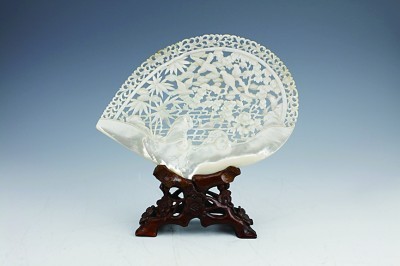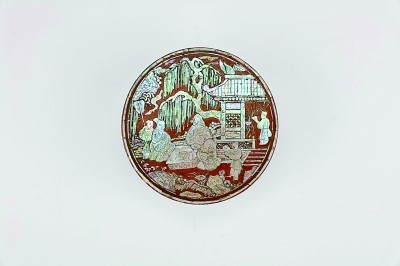See the "shell world" of rare shells and ancient Shu people
Author:Guangming Daily Time:2022.07.18

Some exhibit information pictures

Some exhibit information pictures
【New Exhibition View】
Sichuan is located deep in the southwest, and archeological results in Sanxingdui, Sands ruins and other places show that the ancient Shu people also lived in a rich "shellfish world". The shellfish that once walked with dinosaurs and witnessed the vicissitudes of the earth's 500 million years, once crossed the mountains and sea, came to the Shu land, enriched the lives of the ancient Shu people, and became the "civilized password" that decippped the ancient Shu people's external exchanges today.
Recently, the special exhibition of "Magic Bao 'Beckham' -The Wonderful shellfish World" has completed the exhibition at the Sands Site Museum. More than 1,200 (sets) shellfish specimens and related cultural relics of the five cultural and bloggers including the Site Museum will meet with the audience on July 20. A group of rare shells and ancient Shu people will be concentrated on We in front of us.
A number of ancient Shuhai and shell cultural relics will be exhibited for the first time
A large number of sea shells, bronze shells, and turquoise shellfish were unearthed in the Sanxingdui site. The Chengdu Jinsha site also found that jade shells, shellfish copper wares and other utensils made of sea shells and decorations have also been found. Shudi is far away from the sea. These cultural relics have both real objects and many images of sea shells. Where do they come from?
"There is a tooth groove in the middle of the ring -shaped shells unearthed from Sanxingdui. This kind of sea shells are only produced in the deep sea waters of the Indian Ocean." Relevant experts from the Sands Site Museum pointed out that according to historical records, in northern Indian Ocean, it has been used in history in history. This shell is used as currency. Therefore, these sea shells may be accompanied by trade activities. From India, Myanmar and other countries to Yunnan, to the Chengdu Plain.
According to reports, in addition to the Indian Ocean in the west, Haibei in the ancient Shu area may also come from the South my country Sea region in China, passing Guangdong, Guangxi, Guizhou, and reaching Sichuan. Inspired by the shape of the sea shellfish, the ancient Shu people also used other precious materials to make copper, turquoise shell, jade sea shell, shellfish copper, etc., showing superb artistic creativity.
Archaeologists speculate that in the lives of the ancient Shu people, Haibei may also be a "luxury goods". In important sacrifice activities, with gold wares and jade articles in important sacrifice activities, they are dedicated to the mountains and rivers of the heavens and the ancestors.
In this exhibition, a new round of Sanxingdui ruins will be exhibited for the first time, and the shell -patterned copper wares unearthed from the Sands site will also be rarely unveiled. This bronze is flat and the hollow structure. It is also filled with black inorganic matter when unearthed. Its side decoration has 11 shell patterns of different sizes. It can be seen from the special status of Hai shells in the lives of the ancient Shu people.
A large number of rare specimens will be concentrated
As a exhibition with the largest number of exhibits in the Sands Site Museum over the years, this exhibition exhibits more than 1,200 (sets) exhibits, of which nearly 1,000 pieces (sets) have specimens such as shellfish, fish, corals, etc., from the South China Museum of the South China Sea Museum Some collections are first appeared in the outflows.
In this exhibition, the living environment, population, and categories of shellfish can be presented systematically. 29 rare shellfish specimens such as the snails, Tang Guan snails and Nautilus, the king of shellfish, and the "Sea Rongguang" taro snails are Will be displayed.
The most "senior" of this specimen is Nautilus. It is known as the "living fossil" in the ocean, and has experienced hundreds of millions of years on the earth. Its principle of controlling its own floating invented submarines is deeply inspired. The Pearl Nautilus, which is displayed this time, is listed as a national -level key protection wildlife.
In the rich exhibits, the "Glory of the Sea" Taro snails, because it has the beautiful pattern of the beautiful patterns on the sea when the sea rises and falls on the sun. Its high "face value" It is worth seeing; the largest volume, known as the "king of shell", has a diameter of nearly 1 meter. It is a decorative raw material that has been regarded as the treasure.
In addition, there are the sun -shaped sun -shaped snails, like ancient Shu ivory, but have a longer history of ivory shellfish, in ancient Greek mythology to sort the bone snails of long hair ... rich and precious exhibits, allowing the audience to be in Chengdu can also experience the fun of "catching the sea".
Expand a colorful picture of Beibei culture
In the prehistoric era, it was incompatible with human life, and it also turned into a shell coin, shell carving, snail art, and daily necessities, which appeared in the lives of the ancients. In this exhibition, the audience can follow the long river of time and feel the colorful marks of Bei in human life.
Among them, snails and shell carving arts are particularly noticeable. Ancient craftsmen carved shells, birds, beasts, flowers and plants, or independently made into decorations, or inlaid on lacquer wares or woods. The craftsmanship was inherited for thousands of years and became more and more familiar, colorful and elegant. In this exhibition, the Sailing furniture set that the South China Sea Museum first appeared in the exterior, as well as the portrait of the micro -cutout shellfish, not only vividly described the social life of the time, but also gave the audience a beauty experience.
According to reports, in order to fit the peak of the summer parent -child travel, this exhibition is planned from layout, text language to the design of the exhibition hall, and social education activities. The exhibition creatively combines natural science science and human history, leading the audience to the depths of the ocean, knowing the habitat environment of Hai shell, and shellfish with different gestures and different habits; Class -related cultural relics also launch a historical scroll for the audience.
(Reporter Li Xiaodong)
- END -
18 children infected!This is notified here: stronger infectious, faster communication speed

27 cases of newly added infected people in Zhuhai, Guangdong are all related cases...
Chengdu, advanced "model" advanced

The station's hardware is relatively completeBut have software services considerin...